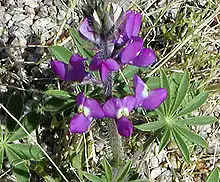| Lupinus arizonicus | |
|---|---|
 | |
| Scientific classification | |
| Kingdom: | Plantae |
| Clade: | Tracheophytes |
| Clade: | Angiosperms |
| Clade: | Eudicots |
| Clade: | Rosids |
| Order: | Fabales |
| Family: | Fabaceae |
| Subfamily: | Faboideae |
| Genus: | Lupinus |
| Subgenus: | Lupinus subg. Platycarpos |
| Species: | L. arizonicus |
| Binomial name | |
| Lupinus arizonicus | |
Lupinus arizonicus, the Arizona lupine, is a flowering plant in the legume family Fabaceae, native to the Mojave and Sonoran Deserts of North America, where it can be found growing in open places and sandy washes below 1,100 metres (3,600 ft) elevation. It is common around Joshua Tree National Park and Death Valley National Park in California.[1]
Description
It is an annual plant growing to 10–50 centimetres (3.9–19.7 in) in height. The leaves are palmately compound with 6–10 leaflets, each leaflet 1–4 centimetres (0.39–1.57 in) long and 5–10 millimetres (0.20–0.39 in) broad, on a 2.5–7 centimetres (0.98–2.76 in) long petiole. The flowers are magenta to dark pink, 7–10 mm long, with 20–50 or more flowers in a tall spike. It is a host of the moth species, Helicoverpa zea.[2]
References
- ↑ Tim Johnson (1999). CRC Ethnobotany Desk Reference. CRC Press. p. 494. ISBN 0-8493-1187-X.
- ↑ "Arizona Lupine, Lupinus arizonicus". calscape.org. Retrieved 2023-10-17.
External links
- Jepson Flora Project: Lupinus arizonicus
- USDA Plants Profile
- Photo gallery
- Mojave Desert Wildflowers, Jon Mark Stewart, 1998, pg. 136